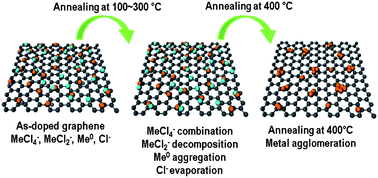Role of ionic chlorine in the thermal degradation of metal chloride-doped graphene sheets†
Abstract
The degradation mechanism of graphene sheets doped with metal chloride was investigated as a function of the annealing process. The sheet resistance of doped graphene increased from 500–700 Ω sq−1 to 10 kΩ sq−1 and the transmittance at 550 nm decreased from 95% to 87–91% after annealing at 400 °C. Furthermore, the work function of doped graphene decreased from 4.7–5.1 eV to 4.2–4.5 eV after annealing. The G and 2D band peaks in the Raman spectra were shifted to lower wavenumbers by annealing at 400 °C, regardless of the kind of dopant, and reached nearly the same level as that of the pristine graphene. X-ray photoemission spectroscopy showed that the chlorine anions and chlorine atoms disappeared after thermal annealing. The scanning electron microscopy images revealed the capability of annealing to gather the unstable metal cations, thereby inducing the aggregation of metal particles. The degree of doping of the graphene sheets was strongly related to not only metal cations but also chlorine anions. Therefore, aggregation of metal particles and adsorption of chlorine ions degraded the properties of graphene as a function of annealing temperature.


 Please wait while we load your content...
Please wait while we load your content...